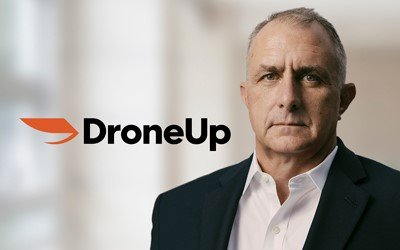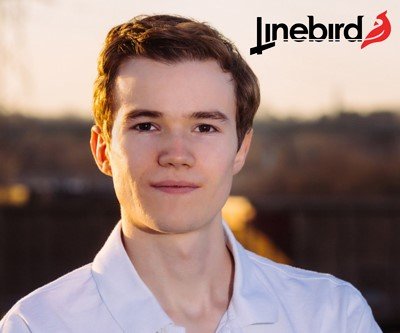Flying high: Virginia’s drone industry is taking off
Speakers (from left to right)::
Tom Walker, who founded DroneUp in 2016, serves as its CEO. DroneUp operates an autonomous drone delivery platform and is a drone services provider. The business received a significant investment from Walmart.
Michael Beiro founded Linebird in 2018 as part of an independent research project while a student at Virginia Commonwealth University. Beiro, a Richmond native, is Linebird’s CEO and one of the Richmond region’s rising entrepreneurial stars.
Delivering merchandise from Walmart to homes using drones could be coming to certain parts of the Richmond area this year.
DroneUp, a Virginia Beach-based company that operates an autonomous drone delivery platform, is partnering with Walmart to offer the drone delivery service.
Drones using Richmond-based Linebird’s technology could be working on electric transmission lines in parts of Virginia by the end of the year.
Drones are rapidly becoming a bigger part of our everyday lives, with unmanned aerial systems performing countless tasks in faster, cheaper, and safer ways. DroneUp and Linebird are two companies leading the way in Virginia.
DroneUp delivery is being made from a Walmart store in northwest Arkansas.
“It is time to start thinking about drones as another tool in the toolbox. Drones are capable of so much more than just taking pictures,” said Michael Beiro, who founded Linebird in 2018 as part of an independent research project while a student at Virginia Commonwealth University.
Beiro and Tom Walker, the founder and CEO DroneUp, talked about the drone industry during the Virtual Innovation Spotlight panel discussion presented by RVA757 Connects. The webinar was held Tuesday May 3.
“People need to realize the possible applications of unmanned aerial vehicles for each of their own business models,” said Beiro, Linebird’s CEO.
“For a cupcake maker or a bakery, drone delivery has huge potential not just on the delivery side, but even on the supply side, helping bring things from vendors into your shop,” he said. “It's a tired pun in this industry, but the sky really is the limit for what applications can be found and what innovations are possible once people start thinking about drones as more than just eyes in the sky.”
Educating the public is key to the future of drone use, he said.
“We need to be creating a positive image of drones in the public for the things that drones can do and the values they can provide to the general public - like the easier delivery, avoiding last-mile problems, avoiding traffic, creating safer work conditions, and preventing utility outages,” Beiro said.
“There are massive benefits that the public may not really be aware of. If they see a drone flying past their house, they might be feeling more suspicious and concerned there's a camera flying around near them and they don't know who it is,” he said. “They are not thinking that the drone could be saving someone from having to risk their neck to keep their lights on or something like that.”
The drone industry is expected to grow to more than $60 billion by 2030, Walker said.
DroneUp
DroneUp has been using its drone technology delivery service from two Walmart stores in northwest Arkansas since December 2021.
Walmart announced plans in May to expand its DroneUp delivery network to 34 sites by the end of 2022 to six states including Virginia. This provides Walmart with the ability to deliver more than 1 million packages by drone in a year.
Here’s how the drone delivery works: Consumers located near a Walmart offering the drone service will be able to log on to droneupdelivery.com to verify that an order can be delivered to their neighborhood. Once verified, the customer orders the products.
Walmart workers get the merchandise and pack the items into a box. A certified DroneUp pilot flies packages to customers’ homes with visual site of the store. A cable on the drone slowly lowers the package into the yard or driveway.
The whole process – from time of ordering to time of delivery - is about a half-hour or less, Walker said.
About 17 minutes of the time right now is waiting for a Walmart employee to pull the product off the shelf and put it in a box, he said. The actual delivery time – once DroneUp gets the product until it is delivered - is about eight minutes. Walmart, he said, is committed to try to get its portion down to about seven minutes.
“We're going to get ours down so we're looking at sub 15 minute delivery time, which we think really meets the impulsive demands of the general public,” Walker said.
About 30,000 SKUs are available for drone delivery, he said. Customers can order items as long as the merchandise safely fits in a box. (Hazardous items and materials are prohibited.)
The No. 1 most ordered item from Walmart for drone delivery has been Hamburger Helper, he said. That is followed by boxed macaroni and cheese, kiwi, children’s Motrin, and diapers.
The first delivery when DroneUp launched the service in December 2021 with Walmart was three cans of StarKist tuna.
The merchandise delivered by DroneUp can’t be heavier than 5 pounds. DroneUp expects the next generation of drones will be able to handle up to 10 pounds.
For comparison, Walker said more than 90% of Amazon’s deliveries weigh 3 pounds or less.
The service is available between 8 a.m. and 8 p.m. The delivery fee is $3.99.
“And by the way, there's no tipping because it's hard to tip the drone in the air,” Walker said with a chuckle.
The company is about to experience significant growth. It had 12 employees in January 2021. DroneUp has slightly over 200 now, and it expects to employ about 650 people by the end of the year.
DroneUp also plans to open a drone pilot training facility. “It looks very likely that it’s going to be here in Virginia,” he said, noting he could not provide details.
By the end of 2023, the company expects to be the largest maker of drones, operating with about 1,300 full-time pilots and delivering millions of packages.
The company’s rapid growth is attributed to a significant investment that Walmart, the world’s largest retailer, made 2021.
Walmart, he said, made the investment to speed up its drone delivery business. “Walmart is our catalyst for growth,” Walker said. About 90% of Americans live within 10 miles of one of Walmart’s more than 4,700 stores.
“We are building our drones and drone technologies to be able to go 10 miles. By the time we're actually achieving that, which we think will be sometime between 2023 and 2024, we will be able to service 90% of the U.S. population out of the Walmart hubs that we will be opening over that period of time.”
Linebird
Linebird was created to help solve the dangerous, expensive and labor-intensive problem of maintenance on electrical powerlines.
“Line work is one of the most dangerous jobs in the country,” Beiro said, noting that 26 linemen died on the job in 2020.
The company created the Osprey Nonconductive Payload System, a patent-pending method for performing hands-on work live transmission infrastructure using modified linemen’s tools.
“It most critically creates a minimize risk to crew because instead of having operators up in the air next to high voltage, their boots are safely on the ground while the work is still getting done,” he said.
Linebird’s products are what you see beneath the drone. The payload system allows the lineman’s tools that would normally fit at the end of an insulated rods that the person would use to be fitted at the end of the drone for work directly on live power lines.
Performing the maintenance duties Linebird’s way allows the work to be completed at a cost that is 10 times cheaper to do with no need to use helicopters, he said. It also is four times faster than bucket trucks and four times cheaper.
“Using drones allow utilities to reach power lines on all terrains, creating minimal disruption to the public,” he said.
Linebird got its start about 4½ years ago while Beiro was conducting an independent research project at VCU. An executive at Dominion Energy asked him to find a way to get a tool on a drone to fix transmission lines.
“It hit me that wow, this is real,” Beiro said when Dominion Energy executive approached him. “This is a top guy at a top power company saying this is a problem. If we can build this, there's going to be something really valuable here.”
The business is still an early-stage company, but Beiro said he expect strong growth this year.
The company is focusing on two categories of products. One is a payload system that allows for access of different power lines, different configurations and from different angles. The other is a broad suite of tools, sensors and installers for getting various tasks done online power lines
Linebird began selling its Osprey system late last year. The technology is currently being evaluated by more than a dozen major investor-owned utilities who are interested in utilizing the product, he said.
“We are looking to make our first couple dozen customers deployments this year.”
Takeaways
At the end of the hour-long webinar, the two speakers suggested some final observations and suggestions:
Beiro said:
The applications and breadth of what is possible with drone technology has only just begun to be discovered. “There is much more out there and many more opportunities for entrepreneurs, for businesses, for innovators, for universities to take on and expand the possibilities of this technology going forward.”
Educating the public about drones is imperative. “Creating a positive image of drones in the public is important for the things that they can do and the values they can provide to the general public.”
Virginia is becoming a massive home for drone business in the U.S.
Walker said:
Drones can have good uses and the public doesn't need to fear them.
Virginia has a real opportunity to develop an economic cluster around unmanned systems. “I would love to see the region continue to invest into unmanned systems and attracting them there. The more that are here, the easier it is for us to hire. Then it would be easier for us to attract people here because they have more than one option for job opportunities other than just a couple of companies.”




